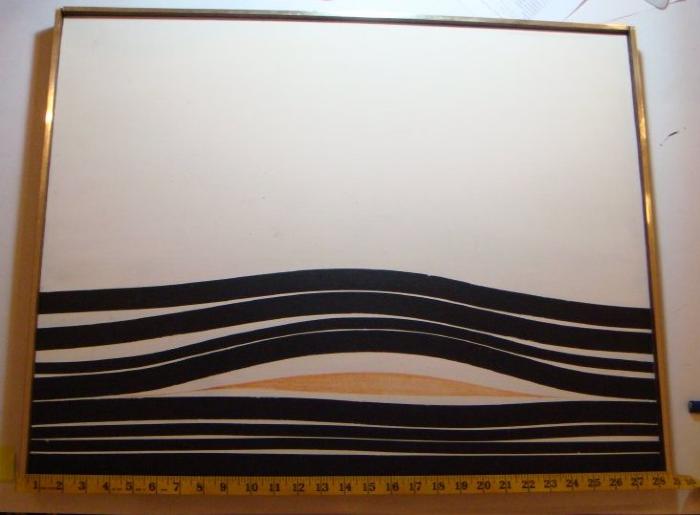Collection of the University of Pittsburgh Art Gallery, Pittsburgh, PA. Gift of Mary Lowenthal Felstiner in honor of Alexander and Anne Lowenthal
1983.01.05
Spatial Rhythm #7
1964 (Date created)
Oil
Painting
Paintings
28.75 in W x 22.5 in H(Object)
Venezuelan;American
Born in Caracas, Alberto Collie studied with the Venezuelan painter Arimando Barrios and the Spanish sculptor Eduardo de Gregoro in Venezuela before continuing his education in the United States at Boston and Harvard Universities. Collie's reputation is largely based upon a sculptural series in which each work is provided with an opus number after the title Spatial Absolute. His first Spatial Absolute, exhibited in 1963, was purchased by Walter Chrysler, Jr. Collie has had several exhibitions, both group and solo, in Venezuela as well as the United States. The Lee Nordness Gallery in New York City has played a prominent role in the promotion of the artist. Collie's painting Spatial Rhythm No. 7 was purchased by the Lowenthals from Nordness Gallery after the painting was exhibited in 1964 at the Carnegie International. The content of Spatial Rhythm No. 7, like all of Collie's work at this time, is abstract. The form is minimal. Nevertheless, the painting should be seen as a continuation of Collie's interpretation of Minimalist sculpture, realized here in two-dimensions. .The Minimalists primarily insist that sculpture or painting is simply an object, an attitude that is an antithesis to the personal involvement implied by Abstract Expressionist painting. The simple shapes employed by the Minimalists are most often specific reflections of modern industrial society. The1960's can be characterized as an era of prodigious space, engineering and computer technological development. Collie's sculptural experiments, in which simple metallic shapes are suspended with minimal support above a pedestal, reflect these tendencies. A technician and engineer himself, Collie capitalized upon his knowledge of magnetic properties in order to defy gravitational pull in the actual suspension of his sculpture in space. Thus by virtue of his materials and the industrially fabricated forms, Collie implies through his sculpture a direct interaction between science and aesthetics which historically had begun with the Impressionists in the nineteenth-century. In 1964 art was often seen as a backdrop for a space and electronics society. Minimalist painting is rarer; sculpture, an art of real rather than implied space, was the preferred medium. In sculpture, Collie's aim was to suspend forms in space without a visible means of support, which at the same time defied one's conception of gravitational pull. In his painted series titled Spatial Rhythms Collie tries to imply a similar kind of levitation of form within the shallow space of the canvas, a space which the artist describes in terms of non-Euclidean space or the fourth dimension. Euclidean space, in simplistic terms, is defined by continuous 4 straight measurable lines. When asked about his own work, Collie replied, "I think in terms of curves, not straight lines." From an exhibition label, unspecified author.
Global Gestures: Post-War Abstraction from the Lowenthal Collection (2.15-3.21.2019)
Using eight solid black lines of varying width but of equal length to suggest a stratified landscape or warped wood grain, Collie focuses our attention on a bulging aperture rendered in a washy peach color. Collie is best known for his “spatial absolutes” or “floating sculptures” in which he defied gravity and freed sculpture from its pedestal. Here, he seems equally interested to suggest gravitational effects and expand the possibilities of painting by presenting forms that appear to extend beyond the frame.
Born in Caracas, Venezuela, and trained in Boston, Collie’s optical art reflects the interests of numerous Latin American artists who sought the effects of sensory and bodily movement through abstract geometric shapes, and often using light and motion. From the late 1940s to the 1970s, such artists contributed to an international avant-garde bound together by shared interests in issues of perception and the technological world that surrounded them. Purchased from New York dealer Lee Nordness, Spatial Rhythm #7was exhibited at the Carnegie International in 1964.
Global Gestures: Post-War Abstraction from the Lowenthal Collection (2.15-3.21.2019)
In Collection
Ex. Coll.: Nordness Gallery, 831 Madison Ave., New York
Mary Lowenthal Felstiner, gift
Mary Lowenthal Felstiner, gift
Please note that cataloging is ongoing and that some information may not be complete.
